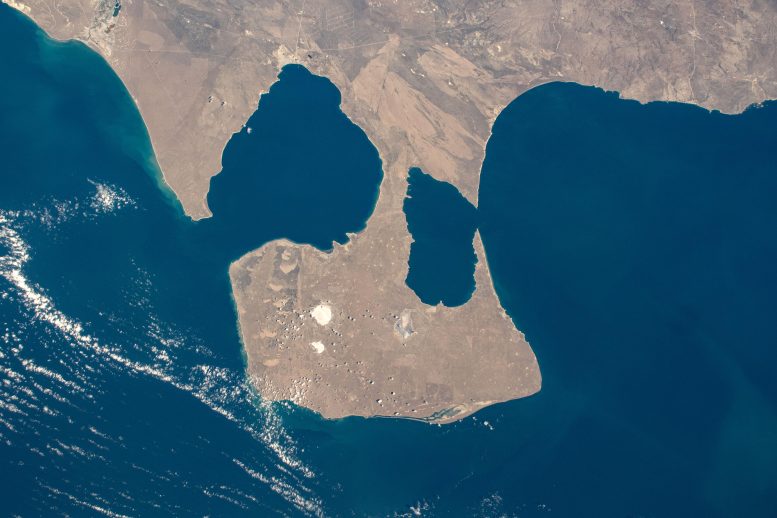The four Axiom Mission 3 astronauts (front row) and the seven Expedition 70 crew members wave to the camera following a crew greeting ceremony on January 20, 2024. Credit: NASA TV
The Expedition 70 crew spent Tuesday on a host of research activities and spacesuit maintenance while assisting their Axiom Mission 3 (Ax-3) guests. The four Ax-3 crew members had their hands full as they explored cancer research, space botany, and robotics for Earth and space benefits.
Astronauts Andreas Mogensen, Loral O’Hara, and Satoshi Furukawa dedicated part of their schedule on Tuesday to the Ax-3 mission. The trio helped the four private astronauts get up to speed with life on orbit as well as conduct advanced microgravity science.

In the Andes Mountain Range, Laguna del Maule (left) and Laguna Fea (right) lie within a volcanic field located in Chile. The International Space Station orbited 267 miles above as this photograph was taken. Credit: NASA
Mogensen from ESA (European Space Agency) spent a couple of hours ensuring the Ax-3 crewmates are familiarized with systems throughout the orbital lab. O’Hara from NASA set up the Life Science Glovebox (LSG) for an Ax-3 space botany investigation while Furukawa from JAXA (Japan Aerospace Exploration) activated a microscope to look at cell samples for an Ax-3 cancer study.
Ax-3 Commander Michael López-Alegría and Mission Specialist Alper Gezeravcı worked in the Kibo laboratory module’s LSG and tested the genetic editing of space-grown plants. Results may enable genetic modifications allowing plants to adapt to weightlessness and promote crew health. Ax-3 Pilot Walter Villadei peered at cell samples inside the Kermit microscope to learn how to predict and prevent cancer both on Earth and in space.

Argentina’s Valdes Peninsula, in between the Golfo San Matias and the Golfo Nuevo and populated by a wide variety of marine and land wildlife, is pictured from the International Space Station as it orbited 269 miles above the Argentine Sea. Credit: NASA
Ax-3 Mission Specialist Marcus Wandt tested the ability to remotely control robots on Earth from the space station. Working in the Columbus laboratory module, Wandt used a laptop computer to command a team of Earth-bound robots simulating a robotic exploration mission on another planet controlled from a spacecraft.
Mogensen would go on to organize food packs, charge virtual reality hardware for a mental health study, and then videotape a space physics demonstration for junior high school students. Furukawa serviced science freezers and combustion research gear before cleaning vents inside the Unity module. Furukawa wrapped up his day with eye checks with NASA Flight Engineer Jasmin Moghbeli. O’Hara operated the medical imaging gear examining the optic nerve, retina, and cornea of both astronauts. Moghbeli earlier installed and tested a camera and lights on a spacesuit helmet.
The orbiting lab’s three cosmonauts from Roscosmos focused on operations in their segment of the International Space Station. Veteran Flight Engineer Oleg Kononenko spent his day inspecting the Zvezda service module and servicing communication and computer systems in the Nauka science module. Flight Engineer Nikolai Chub photographed the condition of Zvezda’s windows and then studied how microgravity conditions such as magnetic and electrical fields affect fluid physics. Flight Engineer Konstantin Borisov deactivated Earth observation gear, downloaded vibration data the station experiences while orbiting Earth, then worked on orbital plumbing duties.





